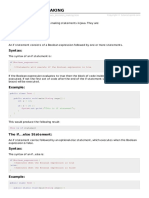0% found this document useful (0 votes)
54 views13 pagesSelection Statements in Java
The document provides an overview of selection statements in Java, including constructs like if, if-else, nested if, and switch statements. It explains the syntax and usage of these statements, as well as the ternary operator as an alternative to if-else. Additionally, it discusses the dangling else problem and the characteristics of switch statements.
Uploaded by
dssamana1011Copyright
© © All Rights Reserved
We take content rights seriously. If you suspect this is your content, claim it here.
Available Formats
Download as PDF, TXT or read online on Scribd
0% found this document useful (0 votes)
54 views13 pagesSelection Statements in Java
The document provides an overview of selection statements in Java, including constructs like if, if-else, nested if, and switch statements. It explains the syntax and usage of these statements, as well as the ternary operator as an alternative to if-else. Additionally, it discusses the dangling else problem and the characteristics of switch statements.
Uploaded by
dssamana1011Copyright
© © All Rights Reserved
We take content rights seriously. If you suspect this is your content, claim it here.
Available Formats
Download as PDF, TXT or read online on Scribd
/ 13


































































































